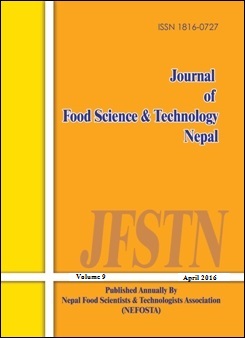Postharvest Handling and Prevalence of Aflatoxin Contamination in Nepalese Maize Produce
DOI:
https://doi.org/10.3126/jfstn.v9i0.16198Keywords:
Maize, Postharvest handling, Aflatoxins, Maximum limitAbstract
In Nepal maize is produced and consumed in significant amount. Summer maize contributes about seventy percent of the total maize production but has high possibility of fungal infection before and during harvest. Traditional practices of post harvest operations and outdoor storage structures are supportive for insect infestation, mold growth and development of mycotoxins. Several studies have shown that the incidence of afl atoxin contamination in maize is high and average prevalence is about 50%. Department of Food Technology and Quality Control (DFTQC), a governmental body reports that about 20% of the maize samples contain aflatoxin greater than the ML (20ppb) as set by the government. On the basis of available data, a simple deterministic exposure assessment for total afl atoxin via maize shows that the situation is alarming and needs immediate attention. In Nepal aflatoxin concern in maize demands a need to further investigation and a risk assessment for revealing the existing situation. This review aims to fi nd out the current situation of aflatoxin contamination in maize produce of Nepal and provide possible ways to reduce the contamination.
Downloads
1167
1068
Downloads
Published
How to Cite
Issue
Section
License
The author will be the copyright holder of this open access journal - 'Journal of Food Science and Technology Nepal (JFSTN)'.




